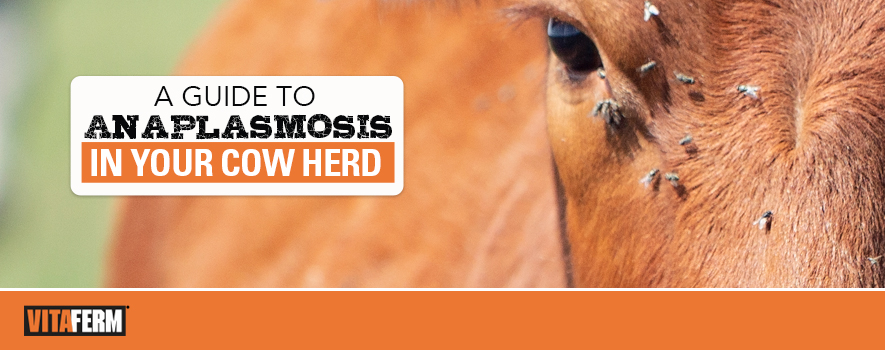
Anaplasmosis is a wide-spread concern to the U.S. beef industry. Cattle in nearly every state are impacted by the blood-borne disease that with proper management can be controlled within your herd.
“With animal diseases like Anaplasmosis, it is very important for cattle producers to have a good working relationship with their veterinarians,” said Kevin Glaubius, Nebraska Area Sales Manager at BioZyme® Inc. “Any medication for control of Anaplasmosis requires a Veterinary Feed Directive (VFD), only available from your vet.”
What is Anaplasmosis?
Anaplasmosis causes destruction of red blood cells by bacteria called Anaplasma marginale. Upon entering a susceptible animal, the anaplasma bacteria slowly invade the animal’s red blood cells, and after a brief incubation period, the animal’s immune system will try to destroy the bacteria. The animal’s body tries to rid itself of the infection, and doing so, the immune system inadvertently destroys the animal’s red blood cells.
There are two common ways the disease is transmitted. The first is through biological vectors like blood-sucking flies and ticks. The second way is through contaminated equipment used for castration, dehorning, tattooing and tagging. While preventing parasites on your operation is unlikely, you can disinfect your equipment in between uses to ensure that the disease is not spread between animals between uses.
Once an animal is infected with Anaplasmosis, it becomes a carrier for life. Although younger cattle are less likely to show clinical signs due to their increased red blood cell production, they are still carriers. Older cattle are likely to show the following symptoms: weakness, loss of appetite and pale skin around the eyes, lips and teats. Later, the animal might become excited, show rapid weight loss or yellow-tinged skin. You might have heard Anaplasmosis referred to as yellow-fever or yellow bag due to the discoloration. The disease is often fatal in older cattle, so if you do suspect you have an infected animal, contact your veterinarian as soon as you can.
“Anaplasmosis has a very slow progression. A tick might bite an infected deer or another infected cow, then later bite one of your cows. The cow’s red blood cells decrease meaning less and less ability to carry vital oxygen, but it might be months later before she shows any signs. And the younger the animal that is infected, the slower it impacts them because they are producing red blood cells much faster,” Glaubius said.
Prevention and Treatment
Perhaps the most efficient way to prevent Anaplasmosis is through parasite control. Reducing biological vectors like flies and ticks can be effective through feeds and minerals that contain IGR, or controlling parasites with sprays, tags, or other control methods. You can also provide a medicated feed or mineral that includes Aureomycin, but remember, to work with your veterinarian to obtain a VFD for the medicated feed.
“We use Aureomycin as a control in our products. The vet still has to write a VFD, and likely still has to verify that you have Anaplasmosis or have had it in your herd so you can use Aureomycin,” Glaubius said.
Aureomycin in the VitaFerm® products is not intended for use in cattle that weigh less than 700 pounds. And, to be sure that all cattle are getting the proper dosage, Glaubius said the antibiotic needs to be mixed in the feed at the proper dose and hand-fed daily as indicated on the VFD. The medicated mineral is not designed for free-choice feeding. As always read and follow label directions, including the instructions on your VFD and check with your veterinarian if you have questions.
BioZyme makes products that include CTC 3G like VitaFerm Concept•Aid® 5/S CTC 3G, VitaFerm Concept•Aid® 5/S CTC 3G with ClariFly® , VitaFerm HEAT® CTC 3G , VitaFerm Conserve® CTC 3G and VitaFerm Conserve® CTC 3G with ClariFly®. Since most of the flies and ticks are present during the summer months, Glaubius recommends feeding the VitaFerm HEAT Aureo beginning in May through the fall, when the parasites are present.
If you do have a severely impacted animal, contact your veterinarian. However, the outcome for very weak and down cattle is usually death.
Where livestock exists, parasites will be present. However, you can work to reduce your likelihood of Anaplasmosis with a good veterinarian relationship and a high-quality mineral program.


